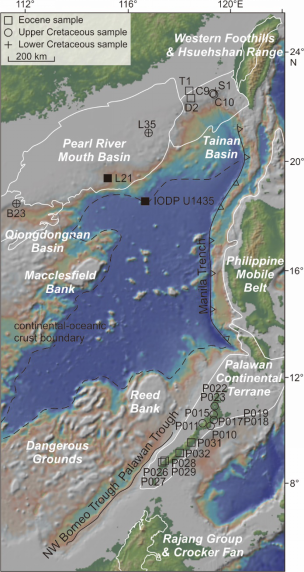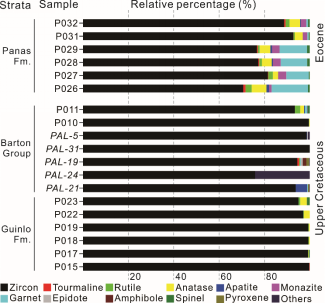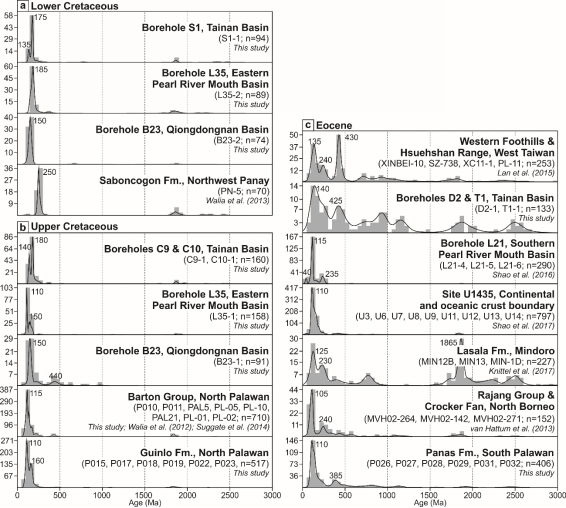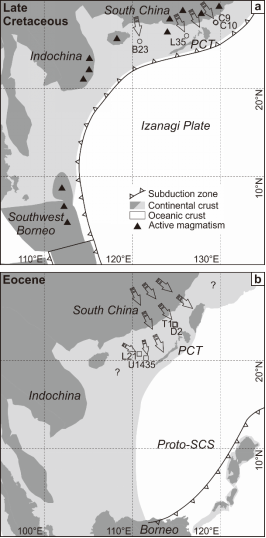巴拉望陆块与南海北部大陆边缘白垩纪-始新世的物源联系
Cretaceous–Eocene provenance connections between the Palawan Continental Terrane and the northern South China Sea margin
南海地区在新生代长期处于拉张的环境,它的板块动力学过程是重建中生代古太平洋-特提斯俯冲体系如何演化至现今复杂的东南亚构造拼贴的重要组成部分。目前,南海的南北两侧分别为巴拉望陆块和华南陆缘,两者一直以来被认为属于共轭的南海被动大陆边缘(图1)。但是,巴拉望陆块的古地理重建,尤其是它何时、何地从华南裂离等问题,一直存在较大不确定性和争议。
针对上述问题,项目组人员2015年初赴菲律宾巴拉望岛开展了野外地质考察,对岛上白垩系至始新统的碎屑沉积物及南海北部同时期的钻井沉积物开展了重矿物分析和碎屑锆石U-Pb测年等工作(图1),拟通过物源分析及相关的古地理重建来揭示巴拉望陆块与南海北部大陆边缘的共轭关系。
沉积物尤其是前新生界地层沉积年龄的不确定性,一直是南海地区物源研究长期困扰的一个难题。此次研究中获取的各个样品的最年轻的锆石年龄,对以往的地层格架做出了进一步的调整和修订。物源分析结果显示(图2、图3):巴拉望北部的上白垩系地层中的重矿物组分几乎全部为锆石,并且锆石结晶年龄多集中在白垩纪;巴拉望南部的始新统地层的在高含量锆石的同时还出现了金红石-锐钛矿-独居石新的矿物组合,而获得的锆石U-Pb的年龄跨度也非常大。
研究发现,巴拉望始新统沉积物并没有继承白垩系的成分特征,故此可以排除巴拉望陆块是在晚白垩纪古南海扩张导致的向南漂移这种可能性。另一方面,巴拉望陆块白垩系-始新统地层的锆石年龄信号与南海东北部地区的同期沉积物具有显著的相似性(图3),表明巴拉望陆块可能与珠江口盆地东侧潮汕凹陷存在一定的共轭关系(图4)。因此,我们认为巴拉望陆块自晚中生代一直拼贴与华南边缘,直到渐新世南海洋壳的扩张才逐渐分离,向南漂移至现今的位置。通过与潜在的物源区进行对比,南海地区东北部的主要沉积物源由白垩纪时期华南边缘的大陆岛弧转变始新世时期华南东南部的内陆一侧(图4),不排除有南海西部供源的可能性。
|
图1南海东部主要构造单元及此次研究的样品分布 |
|
图2 巴拉望上白垩系和始新统地层的重矿物分析结果 |
|
图3南海东部各个地区白垩系-始新统地层的锆石U-Pb年龄分布特征 |
|
图4本次研究巴拉望陆块的物源演化及古地理重建示意图 |
成果资助来源
国家自然科学基金资助项目(91128207, 41576059, and 91228203)
国家科技重大专项(2011ZX05023-03)
作者
Lei Shao(邵磊)
Licheng Cao(曹立成)
Peijun Qiao(乔培军)
Xiangtao Zhang(张向涛)
Qianyu Li(李前裕)
Douwe J.J. van Hinsbergen
Citation:
Shao L, Cao L, Qiao P, et al. Cretaceous–Eocene provenance connections between the Palawan Continental Terrane and the northern South China Sea margin[J]. Earth & Planetary Science Letters, 2017, 477:97-107.
全文链接:https://www.sciencedirect.com/science/article/pii/S0012821X17304661?via%3Dihub
Abstract
The plate kinematic history of the South China Sea opening is key to reconstructing how the Mesozoic configuration of Panthalassa and Tethyan subduction systems evolved into today's complex Southeast Asian tectonic collage. The South China Sea is currently flanked by the Palawan Continental Terrane in the south and South China in the north and the two blocks have long been assumed to be conjugate margins. However, the paleogeographic history of the Palawan Continental Terrane remains an issue of uncertainty and controversy, especially regarding the questions of where and when it was separated from South China. Here we employ detrital zircon U–Pb geochronology and heavy mineral analysis on Cretaceous and Eocene strata from the northern South China Sea and Palawan to constrain the Late Mesozoic–Early Cenozoic provenance and paleogeographic evolution of the region testing possible connection between the Palawan Continental Terrane and the northern South China Sea margin. In addition to a revision of the regional stratigraphic framework using the youngest zircon U–Pb ages, these analyses show that while the Upper Cretaceous strata from the Palawan Continental Terrane are characterized by a dominance of zircon with crystallization ages clustering around the Cretaceous, the Eocene strata feature a large range of zircon ages and a new mineral group of rutile, anatase, and monazite. On the one hand, this change of sediment compositions seems to exclude the possibility of a latest Cretaceous drift of the Palawan Continental Terrane in response to the Proto-South China Sea opening as previously inferred. On the other hand, the zircon age signatures of the Cretaceous–Eocene strata from the Palawan Continental Terrane are largely comparable to those of contemporary samples from the northeastern South China Sea region, suggesting a possible conjugate relationship between the Palawan Continental Terrane and the eastern Pearl River Mouth Basin. Thus, the Palawan Continental Terrane is interpreted to have been attached to the South China margin from the Cretaceous until the Oligocene oceanization of the South China Sea. In our preferred paleogeographic scenario, the sediment provenance in the northeastern South China Sea region changed from dominantly nearby Cretaceous continental arcs of the South China margin to more distal southeastern South China in the Eocene.





